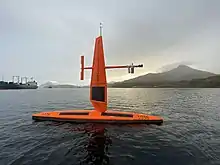Richard Jenkins (engineer)
Richard Jenkins is a 44 year old engineer from Lymington, UK. He is known for engineering and sailing wind-driven vessels on land, ice, and water. In 1999, he founded the Windjet Project while studying mechanical engineering at Imperial College. Since then he has designed, built, and tested four separate speed record craft.[1] Jenkins is currently the founder and CEO of Saildrone,[2] a company that designs, manufacturers, and manages unmanned surface vehicles that sail the world's oceans collecting science data. In 2019, SD 1020 became the first unmanned vehicle to complete a circumnavigation of Antarctica,[3] crossing every longitude line in the Southern Ocean.[4]
| Richard Jenkins | |
|---|---|
| Born | November 1976 |
Early years
Jenkins was born in England to Australian parents. He was raised in Lymington, a small village near Southampton and on his grandfather's farm in Western Australia.[5] He became interested in sailing and engineering at a young age: he was dinghy sailing at age 10, working on the last airworthy Short Sunderland flying boat at age 12, building an International Moth dinghy in his early teens, and doing design work for super maxi yachts while attending college. He first crossed the Atlantic when he was 16.[6] He also helped to sail the Matthew, a replica of John Cabot’s 13th century galleon in which the explorer discovered the island of Newfoundland.[7]
World land speed record
On 26 March 2009, Jenkins broke the world land-speed record for a wind-powered vehicle.[8] He reached 126.1 mph (202.9 km/h) in his land yacht Greenbird on the dry plains of Ivanpah Lake in Nevada. The previous record of 116 mph (187 km/h) was set by American Bob Schumacher in 1999, driving his vehicle the Iron Duck in the same location. "Top speed is actually quite scary. The structure and tyre grip is all at the limit, so keeping it in a straight line under full control takes full concentration," Jenkins told The Guardian.[9]
Greenbird is the fifth iteration of the land yacht that was first known as Windjet. Greenbird is powered by a carbon composite wing that produces thrust similarly to how an airplane wing produces lift.[10]
Jenkins attempted to break the world record for sailing on ice on the frozen Canyon Ferry Reservoir in Montana with a vehicle adapted for ice.[11]
Saildrone

The innovation that allowed Greenbird to break the land speed record was a unique wing/tail/tab system that produced aerodynamic wing control. A tail mounted midway up the wing allowed for very precise control of the "angle of attack" of the wing to produce maximum power while consuming very little energy. Jenkins adapted that system to an autonomous surface vehicle known as a saildrone and founded a company by the same name.[12] Saildrones are wind powered for forward propulsion and use solar to power onboard sensors and computers[13] used to gather ocean data[5][14]
In 2013, Saildrone 1 (SD 1) became the first unmanned surface vehicle to cross an ocean using only wind power. The saildrone was deployed from San Francisco on October 1 and sailed 2100 nautical miles arriving in Kaneohe, Hawaii, 34 days later.[15]
2019 Antarctic circumnavigation
The First Saildrone Antarctic Circumnavigation mission, funded by the Li Ka-shing Foundation, was launched from Point Bluff, New Zealand, on January 19, 2019. The 196-day mission covered 13,670 miles (22,000 km) in the Southern Ocean and returned to the same port on August 3, 2019. During the mission, SD 1020 had to survive freezing temperatures, 50-foot waves, 80 mph winds, and even collisions with giant icebergs. SD 1020 had a special "square" wing designed especially for the Southern Ocean. “While the square rig has less performance range than the regular saildrone wing and struggles to sail upwind, it does a great job of sailing downwind and can still get you where you need to go in the Southern Ocean. You inevitably sacrifice maneuverability for survivability, but we have created something that gets the job done and that the Southern Ocean just can’t destroy!" said Jenkins in a company blog post.[3] The voyage is a "a technological feat that was unfathomable just a decade ago."[16]
References
- About the Windjet Project. http://www.windjet.co.uk/index.php?option=com_content&task=view&id=176&Itemid=112
- "Saildrone: About". www.saildrone.com. Retrieved 5 August 2019.
- "Saildrone Completes First Autonomous Circumnavigation of Antarctica". www.saildrone.com. Retrieved 5 August 2019.
- "Saildrone's Journey Around Antarctica Uncovers New Climate Clues". Bloomberg.com. 5 August 2019. Retrieved 8 September 2020.
- "This Man Is Building an Armada of Saildrones to Conquer the Ocean". Bloomberg.com. Retrieved 28 March 2019.
- Fisher, Adam. "The Drone That Will Sail Itself Around the World". Wired. Condé Nast. Retrieved 18 February 2014.
- Greenbird: About the team. http://www.greenbird.co.uk/about-the-greenbird/the-team
- Wind powered car breaks record. http://news.bbc.co.uk/2/hi/technology/7968860.stm
- Adam, David; correspondent, environment (20 August 2008). "Richard Jenkins hopes to set a new wind-powered landspeed record". The Guardian. ISSN 0261-3077. Retrieved 25 July 2019.
- Squatriglia, Chuck (21 August 2008). "Riding the Wind Into the Record Book". Wired. ISSN 1059-1028. Retrieved 25 July 2019.
- Roe, Nicholas (6 January 2009). "Greenbird ice yacht: Sailing towards a miracle on ice". ISSN 0307-1235. Retrieved 25 July 2019.
- "How the Saildrone Wing Was Born". www.saildrone.com. Retrieved 26 July 2019.
- "What Is a Saildrone and How Does It Work?". www.saildrone.com. Retrieved 26 July 2019.
- "Crunchbase - Richard Jenkins". Crunchbase.
- "Saildrone: New World Record for Autonomous Sailboat >> Scuttlebutt Sailing News". Scuttlebutt Sailing News. 17 November 2013. Retrieved 26 July 2019.
- "Saildrone is first to circumnavigate Antarctica, in search for carbon dioxide | National Oceanic and Atmospheric Administration". www.noaa.gov. Retrieved 5 August 2019.
